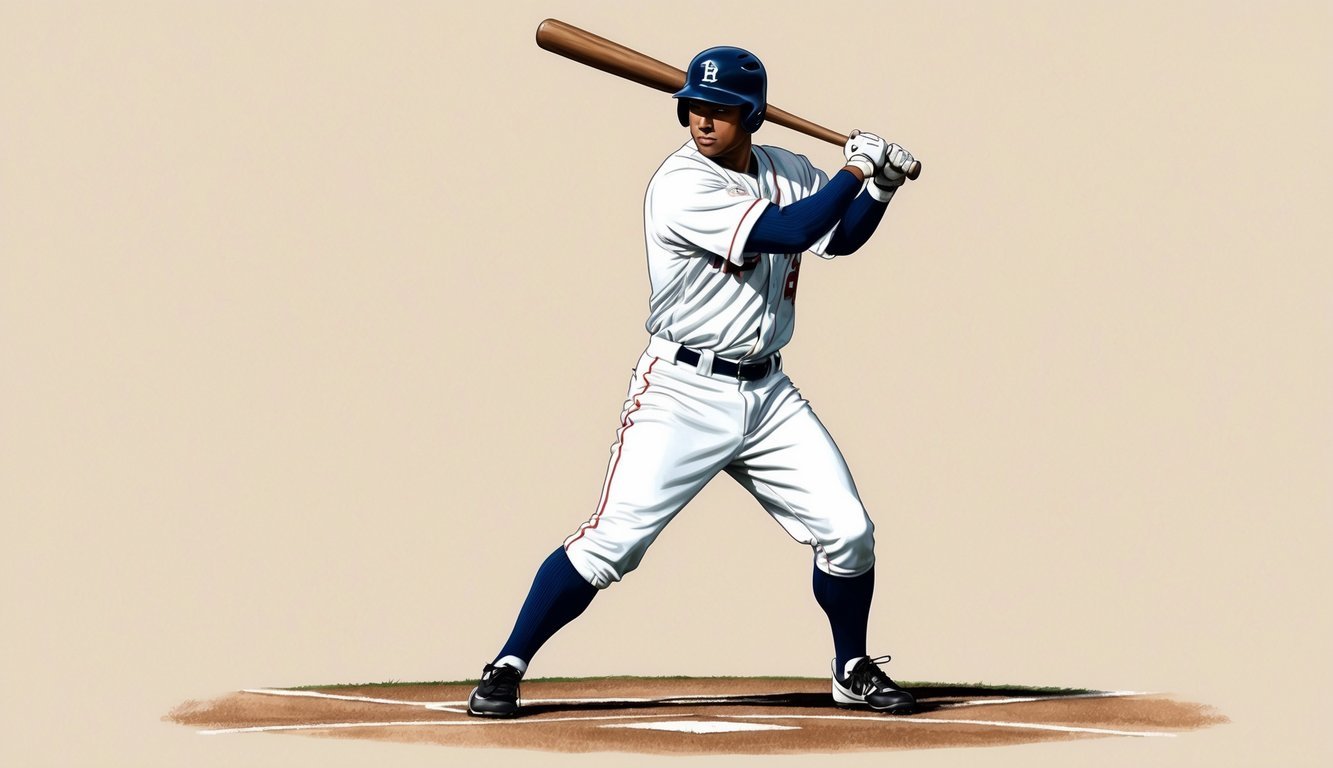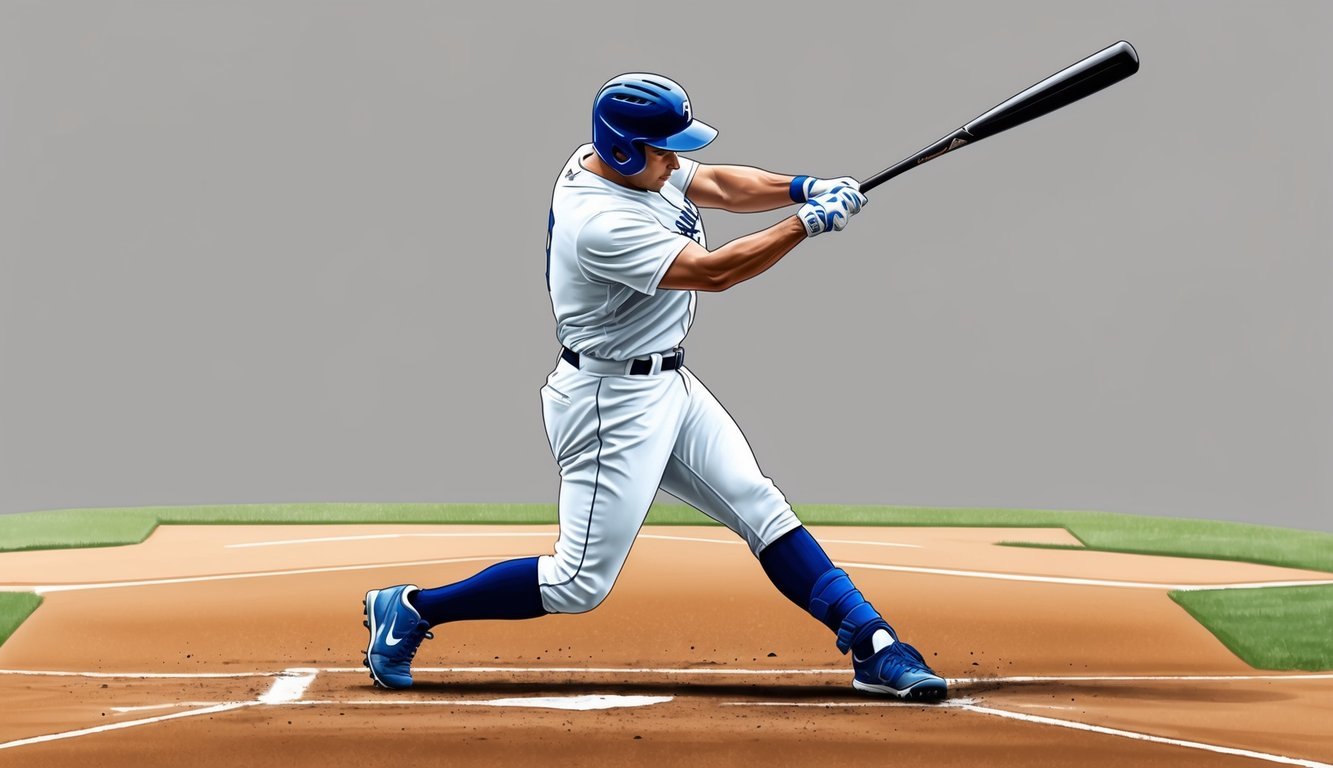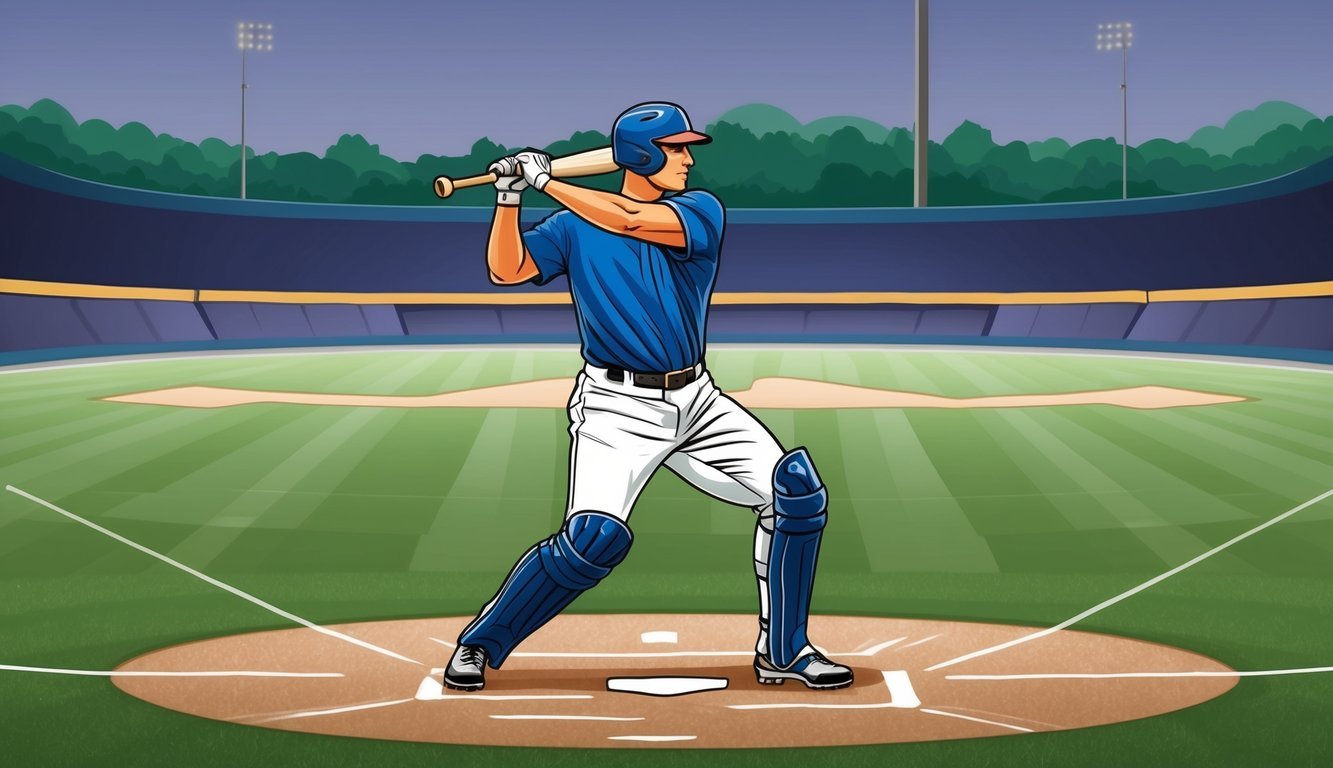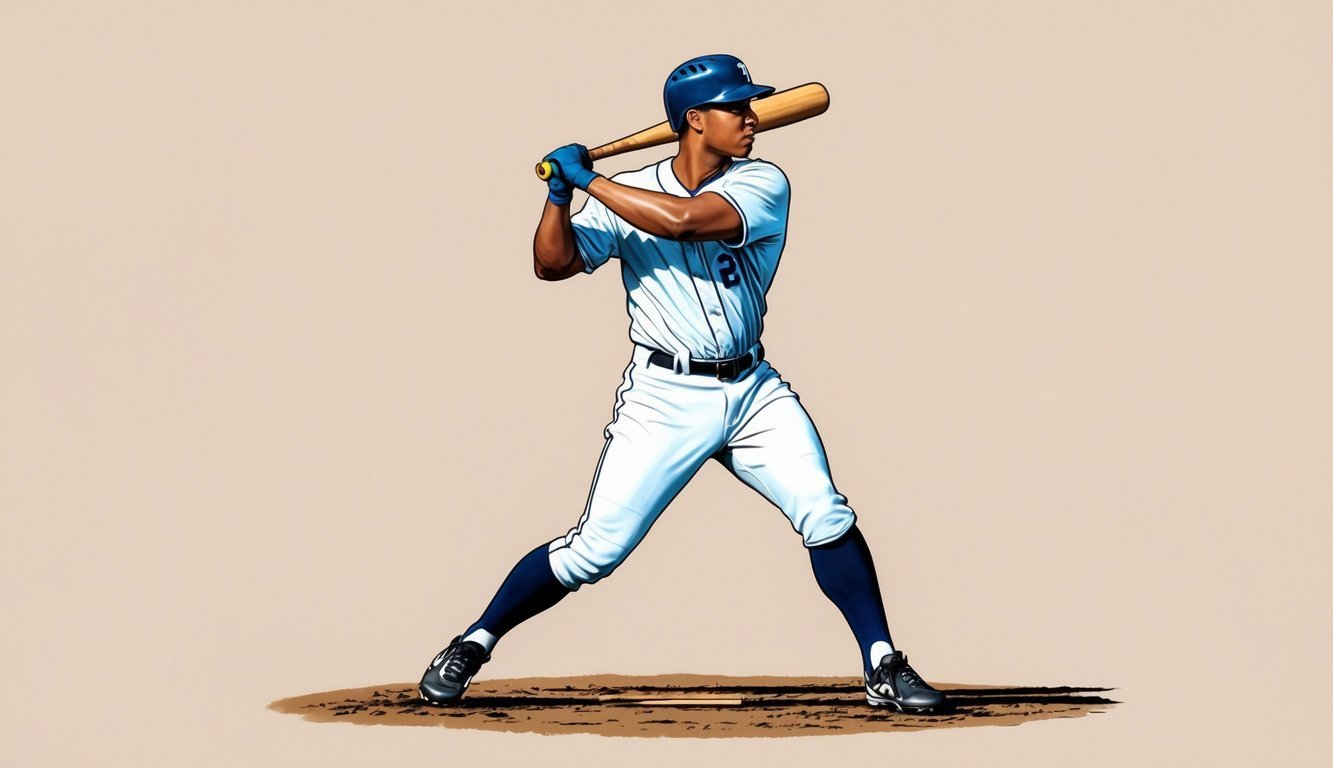A batter’s stance is the foundation of a powerful and effective swing in baseball.
It’s the starting position that sets up everything else in the hitting process.
The ideal batting stance balances a player’s weight, aligns their body, and positions their hands and eyes for optimal contact with the ball.
Every hitter develops a unique stance that feels comfortable and natural to them.
Some prefer an open stance with the front foot angled away from the plate, while others opt for a closed stance with the front foot closer to the plate.
Many hitters use a square stance, with feet parallel to the plate.
Each variation offers different advantages in terms of vision, power generation, and plate coverage.
Perfecting your batting stance takes practice and experimentation.
Top hitters often adjust their stance based on the pitcher they’re facing or the type of pitch they’re expecting.
By finding the right stance, batters can improve their timing, balance, and overall hitting performance on the field.
Understanding the Basics of a Batting Stance
A proper batting stance forms the foundation for successful hitting in baseball.
It combines comfort, balance, and proper body alignment to set up a powerful swing.
The Role of Comfort and Balance
Comfort is crucial in a batting stance.
Players should feel relaxed and natural in their position at the plate.
This allows for smooth, fluid movements when swinging.
Balance is equally important.
A stable stance helps batters maintain control throughout their swing.
Distributing weight evenly between both feet aids in quick reactions to pitches.
Many players wiggle or make small movements to stay loose.
These pre-swing rituals can help batters feel more comfortable and focused.
Positioning Your Feet
Foot placement is key to a solid batting stance.
Most batters start with their feet shoulder-width apart or slightly wider.
The front foot often points slightly toward home plate.
The back foot typically aligns parallel to the plate.
This creates a slightly open stance.
Some batters prefer a closed stance, with the front foot further back.
Others use an open stance, with the front foot closer to the plate.
Experiment to find what works best.
Toes should grip the ground lightly.
This helps with balance and quick movements.
Aligning Your Body
Proper body alignment completes a strong batting stance.
Knees should be slightly bent, creating a athletic, ready position.
The chest faces the pitcher, with shoulders level.
This allows for a clear view of incoming pitches.
Arms are typically relaxed, with the bat held comfortably near the back shoulder.
Elbows should be loose, not locked.
The head stays still, eyes focused on the pitcher.
Good posture helps batters track the ball effectively.
Remember, there’s no one-size-fits-all stance.
Players should adjust these basics to suit their individual style and strengths.
Types of Batting Stances
Batting stances in baseball come in three main varieties, each offering unique advantages and challenges for hitters.
These stances form the foundation of a batter’s approach at the plate and can significantly impact their hitting performance.
The Open Batting Stance
An open batting stance positions the front foot farther from home plate than the back foot.
This stance provides excellent vision of incoming pitches, especially for batters who struggle to see the ball well.
It can be particularly effective against pitchers with deceptive deliveries.
Benefits of the open stance include:
- Improved view of the pitcher
- Easier to hit inside pitches
- Can help generate more power on pull-side hits
Potential drawbacks:
- May leave batters vulnerable to outside pitches
- Can reduce power to the opposite field
Many hitters find success with an open stance, as it allows them to start their swing earlier and adjust to different pitch locations more easily.
The Closed Batting Stance
In a closed batting stance, the front foot is closer to home plate than the back foot.
This positioning can help batters cover the outside part of the plate more effectively and drive the ball to the opposite field with greater ease.
Key advantages of the closed stance:
- Better coverage of outside pitches
- Increased power to the opposite field
- Can help batters stay back on off-speed pitches
Possible disadvantages:
- Reduced vision of the pitcher
- May struggle with inside pitches
Hitters who excel at hitting to the opposite field often prefer a closed stance.
It can also be beneficial for batters looking to improve their timing on breaking balls.
The Square Batting Stance
The square batting stance aligns both feet parallel to home plate.
This balanced approach offers a compromise between the open and closed stances, providing a solid foundation for hitting to all fields.
Notable features of the square stance:
- Even weight distribution
- Good plate coverage
- Versatility in hitting to all fields
Potential limitations:
- May not maximize power or vision like specialized stances
Many coaches recommend the square stance for beginners as it teaches proper weight transfer and balance.
It’s also a popular choice among contact hitters who prioritize putting the ball in play consistently.
Batting Stance Adjustments for Better Hitting

A proper batting stance forms the foundation for successful hitting.
Small tweaks can make a big difference in power, accuracy, and overall performance at the plate.
Hand and Arm Positioning
Proper hand and arm placement is crucial for a fluid swing.
Hitters should keep their hands up, but not higher than their shoulders.
This creates a straight line from the back elbow to the shoulder, promoting a quicker, more effortless swing.
For a comfortable grip, align the knuckles of both hands.
This helps generate bat speed and control.
The back elbow should be relaxed and slightly away from the body, allowing for a smooth path to the ball.
Some players find success by experimenting with hand position.
Moving hands slightly forward or back can affect timing and power.
It’s essential to find what feels natural and produces consistent results.
Getting Your Head in the Game
A batter’s head position greatly influences their ability to track the ball.
Keeping the head still and eyes focused on the pitcher is key.
This enhances concentration and improves pitch recognition.
Tilting the head slightly towards the front shoulder can help some hitters see the ball better.
However, avoid excessive tilting, as it may disrupt balance and limit vision.
Many successful hitters use a slight head turn towards the pitcher as the pitch is delivered.
This subtle movement can improve depth perception and reaction time.
Footwork and Weight Distribution
Proper foot placement and weight distribution create a stable foundation for hitting.
Start with feet shoulder-width apart, then move the front foot 5-7 inches towards the pitcher.
Bend the knees slightly to maintain balance and allow for quick weight transfer.
Most hitters find success with about 60% of their weight on the back foot initially.
As the pitch approaches, a small stride or weight shift to the front foot helps generate power.
This movement should be smooth and controlled, not disruptive to timing or balance.
Experiment with open, closed, or square stances to find what works best.
Each offers different advantages in plate coverage and swing mechanics.
Mastering the Mechanics of a Powerful Swing

A powerful baseball swing combines precise body mechanics with perfect timing.
Proper setup, hip movement, and contact point are crucial elements that contribute to hitting success.
To maximize power, hitters should focus on generating torque through their hips while maintaining balance throughout the swing.
Additionally, staying disciplined with pitch selection and following expert advice, such as mvr baseball tips, can help batters make consistent, solid contact.
From Setup to Contact
The foundation of a strong swing starts with the proper setup.
Feet should be shoulder-width apart, with the front foot slightly open.
Weight distribution is key – about 60% on the back leg.
Hands should be positioned comfortably near the back shoulder.
The bat should be held at a 45-degree angle to the ground, ready for action.
As the pitch approaches, initiate a small stride towards the pitcher.
This step helps generate momentum and power.
Keep your head still and eyes focused on the ball throughout the swing.
The bat should remain perpendicular to the ground as it moves through the strike zone.
This ensures optimal contact with the ball.
At the point of contact, your arms should be extended, forming a powerful lever.
The bat should meet the ball slightly in front of your front foot for maximum impact.
The Importance of Hip Movement
Hip rotation is the engine that drives a powerful swing.
As you begin your swing, your hips start to rotate towards the pitcher.
This movement generates torque and explosive power.
The key is to lead with your hips, not your hands.
Your lower body should initiate the swing, with your upper body following.
This sequence creates a whip-like effect, increasing bat speed.
As your hips rotate, your weight shifts from your back leg to your front leg.
This transfer of energy flows up through your body and into the bat.
Proper hip movement also helps maintain balance throughout the swing.
It allows for a smooth follow-through, reducing the risk of injury and improving overall swing consistency.
Practice hip rotation drills to enhance this crucial aspect of your swing.
Focus on explosive movements and maintaining a stable core for optimal results.
Choosing the Right Batting Stance as a Beginner

Finding the perfect batting stance is crucial for new baseball players.
It forms the foundation for a successful swing and can greatly impact performance at the plate.
Let’s explore some key considerations for beginners.
Exploring Various Stances
Beginners should experiment with different batting stances to find what feels natural.
The three main types are open, closed, and square stances.
An open stance has the front foot further from the plate, allowing a clearer view of the pitcher.
A closed stance positions the front foot closer to the plate, which can help pull the ball.
The square stance aligns both feet evenly.
Young hitters can try each stance during practice to see which offers the best balance and comfort.
It’s important to keep the head up and maintain a stable position throughout the swing.
Practical Tips for Young Baseball Hitters
New baseball players should focus on consistency and comfort when developing their stance.
Here are some helpful pointers:
- Keep feet shoulder-width apart for good balance
- Bend knees slightly for flexibility
- Hold the bat at a comfortable angle
- Maintain relaxed shoulders and arms
- Position hands away from the body
A low stance can help beginners stay balanced and track the ball better.
As players gain experience, they can adjust their stance to suit their hitting style.
Practice is key.
Young hitters should spend time in the batting cage to refine their stance and swing.
With repetition, the proper stance will become second nature, allowing players to focus on making solid contact with the ball.
